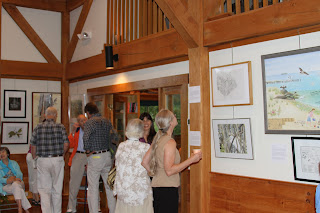Sunday afternoon, May 20th, we took another field trip which combined birding and a bird artist. The town of Kent, in western Connecticut is famous in birding circles for its spring warbler migration, and perhaps less famous for its early 20th century bird artist, Rex Brasher. What drew us there on this particular day was a presentation about Rex at the local historical society - coinciding with, well, spring migration.
 |
| Spring woodland along River Road in Kent, Connecticut |
Kent Historical Association Presentation
The Kent Historical Association hosted two grand-nieces of artist Rex Brasher (pronounced not the way I expected, but instead BRAYzher), Deborah and Melode Brasher, who read a prepared biography of their great uncle and told a few stories with some local color. On display were some hand-colored prints and a few books.
 |
| Roseate Tern, Sterna dougallii, hand-colored lithograph by Rex Brasher |
Rex Brasher biography
It's difficult to summarize Rex Brasher's life. Born in 1869, died in 1960, painted, travelled, struggled, triumphed, struggled and painted some more. As a young child, he heard his father's story of having been snubbed by the aging John James Audubon, and determined to right the wrong by painting every North American bird, from life. To this end, he travelled to all corners of the United States to study birds, and earned money in various ways to support his travels and his life as a painter.
 |
| Greater Roadrunner, Geococcyx californius, (detail), hand-colored lithograph by Rex Brasher |
In 1924 he painted the 874th and final bird of the series, the LeConte's Sparrow. Color reproductions being too expensive to publish, he found an engraver to make black and white lithographs, which he then hand colored. The finished book, Birds and Trees of North America, was presented in twelve volumes, and sold by subscription - only one hundred copies were made.
In 1941 Rex Brasher's original paintings and prints were purchased by the state of Connecticut, eventually to land at the University of Connecticut, where they are housed in the Thomas J. Dodd Research Center's Archives and Special Collections. The
Dodd Center is a UConn library, and is open to the public.
Link to page for the Brasher Collection.
 |
| Secrets of the Friendly Woods. Musings on Rex's Connecticut woodlands and its inhabitants. |
New Brasher exhibit
The head of the Board of the Rex Brasher Foundation spoke of renewed efforts to increase the visibility of the great opus of Rex Brasher's life, his
Birds and Trees of North America. The most visible of these efforts is an exhibit of fourteen paintings at the
Connecticut State Museum of Natural History. On exhibit are digital reproductions, not the originals, and the intent is that this set, grouped as "The Endangered and Threatened Birds of Connecticut", will be a travelling (and fund-raising) show.
Now back to Kent
To bring my story full circle, midway through his life, Rex Brasher purchased a 150-acre farm near Kent, Connecticut, where he lived and painted and associated with other artists and naturalists.
 |
| Yellow-throated Vireo, Vireo flavifrons, www.avesinart.com |
Birding Kent's River Road in May
Northbound songbirds follow the Housatonic River and its adjacent mountain ridge, and are abundant in early May in the woodlands along an unpaved road that follows the river's western shore - River Road. Where the road ends, a broad, well-traveled footpath continues - the Appalachian Trail - traversing the northwest corner of Connecticut. Geology and topography combine to create a beautifully inviting atmosphere for any outdoors enthusiast - cool shady woods for hiking, a fast-flowing river for paddling, unique plant communities for botanizing, and of course the migrating songbirds.
We had far more mosquitoes than birds, but the birds were beautiful ones: Cerulean Warbler, Blackburnian Warbler, Northern Parula, Yellow-throated Vireo, Red-eyed Vireo, Scarlet Tanager, Black-billed Cuckoo, Great-crested Flycatcher, Common Nighthawk, Purple Martin, Common Merganser and many more.
 |
| Cerulean Warbler, Setophaga cerulea, www.avesinart.com |
Find directions to River Road at end of this post.
Housatonic Valley Geology - an interesting digression
Geologically, the Housatonic River valley is complex, with the low but steep mountains formed of folded and faulted metamorphic bedrock (Precambrian gneiss and schist). During the Paleozoic era, much of the river valley was underwater - salt water - which left behind a carbonate sediment of shells and marine fossils. This material became limestone, which metamorphosed into marble - visible in the exposed outcrop at
Kent Falls State Park, just north of the village of Kent.
More Brasher links:
Link to an art gallery website which has images of plates of Brasher's
Birds and Trees of North America as well as excerpts from a biography written by nephew Milton Brasher.
Link to that biography at Amazon and
link to same at Google books.
http://www.nytimes.com/2008/08/03/nyregion/nyregionspecial2/03kentct.html?pagewanted=print - New York Times article "Painter of Birds to Finally get a Home"
Link to my source for explaining the geology that was so evident all around us in the woods along River Road.
Directions to River Road, Kent:
From the center of Kent, cross the river on Bridge Street (route 341), immediately turn right (N) on Skiff Mountain Road, and follow for 3 miles (you'll pass the athlectic facilities for Kent School), keep going to the end where there is space for a few cars to park.




























































